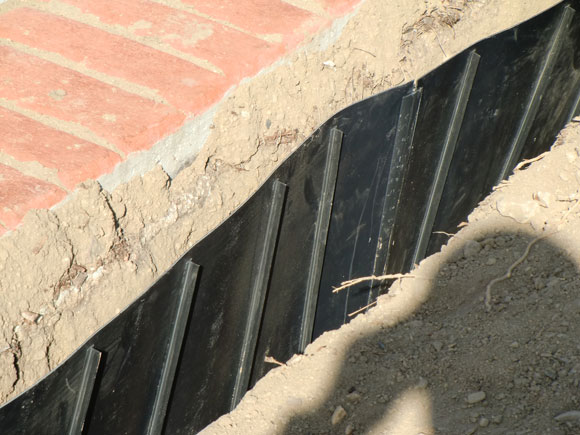A great question came in this week to Ask Gardenerd:
“It’s Yvette from Mar Vista!!! I have a BURNING QUESTION!!! We have a big big rainbow eucalyptus tree in our front yard that is causing big, big problems with our raised beds…the roots (mostly small tangly ones) keep invading and stealing all the water and nutrients from them and we had a horrible harvest…we want to put in a root barrier but we don’t know anything about it. Might you have some tips for us? XXXOOOOOOOOOOOOO”
Yvette, your problem is unfortunately a common one. We plant our gardens, then nearby trees discover it and move in, lacing our garden beds with a thatch of fine root hairs that prevent our veggies from thriving. It becomes almost impossible to dig and our plants suffer lack of water and nutrients, just as you said. What to do?
Image provided by Villarootbarrier.comHere are a couple of options, both require some work:
1) Install a vertical root barrier – this is the most effective option (pictured above) because it’s a physical deep barrier that forces roots down instead of out. Installing it around the drip line (the outer edge of the canopy) will prevent further infiltration. It requires a 2-3 foot deep trench, but it’s what I recommend if you can afford to do it. Companies like Deep Root offer materials and installation, or perhaps your regular gardener can do it with supplies from a local hardware store. Installation is basically this: dig a trench, place the root barrier vertically, backfill the trench.
2) Install horizontal barriers under each bed – this is also effective, because it stops the roots from stealing from your plants, but it may wear out over time. This is one of those things that would be best done before the beds were installed, but in a pinch you can do it after. Here’s how it goes:
Remove all soil from inside the raised beds (if already installed). If you can flip the raised beds over, do it. Use screws and washers to secure 1/2″ hardware cloth to the underside of the raised bed.
Then install a layer of weed fabric over the hardware cloth (a staple gun will do the trick). The weed fabric prevents roots from getting through, and the hardware cloth prevents roots from pushing the weed fabric up (if you were able to flip your raised beds over for installation, the weed fabric would be installed on top of the hardware cloth, then when you flip the bed back over, it would be on the bottom, touching soil). If your beds are affixed to the soil and flipping them is not an option, install the weed fabric underneath the hardware cloth inside the beds. It will still help.
Weed fabric may wear out over time or tear if you dig deep in your beds (maybe now is a good time to adopt a no-till method?), but it’s better than plastic lining because it allows water to flow through. Those tree roots will still get some water, but they won’t interfere with your veggies and herbs.
Happily Ever After…maybe
These options allow your tree and garden beds to live in harmony, with well-defined boundaries. If neither of these options work for you, then there is option #3) make a plan to dig out the roots every 2 years or so and start fresh.
I hope this helps, Yvette! Keep us posted on what you decide to do.
BTW folks – Yvette is a fantastic photographer in the Los Angeles area. Check out her work and hire her for your next event/project.



If beds are raised, it shouldn’t always be necessary to dig such deep trenches. Our wooden beds are one foot high and filled with soil. Our many dwarf citrus trees planted well above the beds have sent their roots into our beds, which are infested with their feeder roots. We’ve been digging out the roots with a Root Slayer, which is quite effective. Within the bed, we have to dig down from 6 inches to 14 or so inches to reach the main roots. However the garden paths are one foot lower, so the main roots are entering the raised bed just below the level of the path. Thus, we are digging a narrow trench on the path behind the the upper beds. We find that a ten inch trench is well below the primary citrus root level. Home Depot sells a one foot high 50 foot roll of 60 mm HDPE root barrier for about $65, free home delivery. We plan to install it, leaving two inches above the path, as recommended. We’ll write again to report whether it does the job.
The soil in my existing in ground vegetable garden is exhausted. I want to learn a no till process but first need to decide if I can revitalize this garden soil or should I start over in new soil. So how do i revitalize this old soil and no till it or start over with no till in a new place? Do you have info for no till also?
I’m a big fan of reusing soil, but to know if the soil should be replaced (for example, if it has lead or high zinc or high copper in it) you can send a sample off to a lab. Wallace Laboratories does a great soil and heavy metal combination test. If you’d rather just add amendments, you’ll want to work those in and then switch to no-till. A digging fork will disturb soil structures less than a rototiller. That’s the best approach for amending soil. Lay down an inch or two of compost on the top, work it in with a digging fork, then water it in. We have a YouTube video on bed prep as well, if you need visual aids. Other ways to prep soil for no-till is to grow a deep dive crop like daikon radishes to break up compacted soil, then add compost and lightly work it in. I hope this helps.
I’m thinking that if I simply trench between the neighbors tree and my garden every year or two, it will solve the problem. Rent a trencher pnce and put down barrier or just trench? At least till I redo my raised beds. Has anyone had any success like this?
That is one way to manage the issue. The deeper roots may still find your garden, but it’s a good start. Just make sure you don’t get too close to your neighbor’s tree or cause damage for it down the line. Keep the neighbors happy, I always say.
So sorry, but option 2 did not work for me. I cleaned out all tree roots from prior year and installed wire and weed fabric. One year later, the beds were totally laced with roots again. Tiny, tiny root tendrils came up through the pinholes in the fabric, then grew to enlarge the hole in the fabric – and then infested the whole bed all over again!! And that in ONE YEAR!!
Sorry to hear about that, Paul. I’m guessing this works better with some trees and shrubs over others. The only other thing that works, but requires a lot of time and possibly money in labor costs, is to dig a 3 foot deep trench and install a root barrier around the perimeter of the garden. It’s something I recommend people do early on when putting in the garden, but most people don’t want to do that kind of work. I hope you’re able to keep the roots at bay with a little less effort in the future, but I know that sounds like a tall order. Don’t give up!